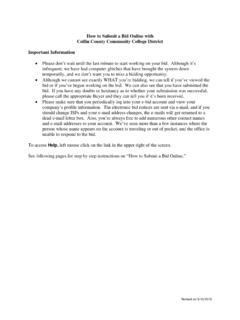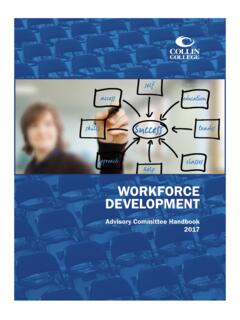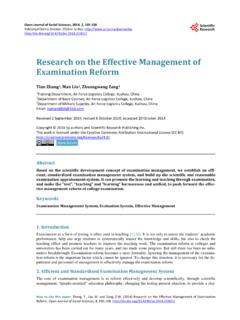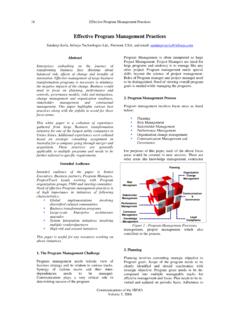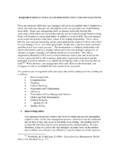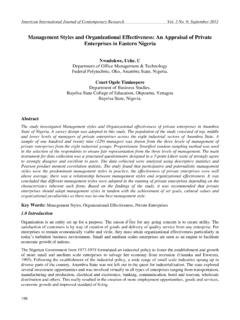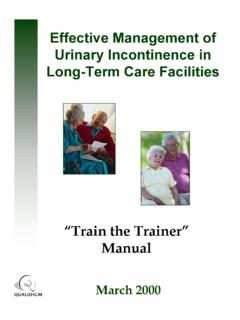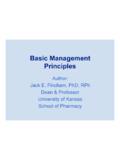Transcription of Effective Strategies for Personal Money Management
1 2004 Center for Personal Financial Education 1 Effective Strategies for Personal Money ManagementThe key to successful Money Management is developing and following a Personal financial plan. Research has shown that people with a financial plan tend to save more Money , feel better about their progress, and make more appropriate decisions no matter what their income. Moreover, a written financial plan is far more Effective than a mental one. Seeing your plan in writing helps to remind you about what actions are necessary to reach your goals and it helps you to check your progress more easily than relying on memory alone. A successful financial plan can be developed in six steps: 1. Set goals 2. Prepare a net worth statement 3. Gather past income and expense records 4. Complete the Spending and Saving Planner 5.
2 Keep records of spending and saving 6. Evaluate Step 1: Set Goals First, take time to set goals and decide as a family what you hope to accomplish financially. Knowing what is important to you and your family is a critical first step in a successful Personal financial plan. Use the Setting Goals worksheet to decide which financial goals are most important to the family and how much will be needed each month to accomplish these goals. A well-defined financial goal is: specific - what you want to achieve. measurable -- how much Money you will need. tied to a time frame -- when you want to achieve the goal. reasonable it can be achieved with the time and Money available. The following is an example of a well-defined financial goal: I want to buy a house that costs around $150,000 in 2007.
3 This goal is specific, measurable, and tied to a time frame. It is reasonable when you are willing and able to include the goal in your everyday spending priorities. Prioritize goals in terms of their importance to you and your family. Goals will differ in the length of time needed to achieve them. It may not be possible to start working on all goals in the same year. However, long-term goals need a place in the financial plan over time. Both short- and long-term financial goals will require regular savings. The first short-term goal for every family should be an emergency cash reserve. In addition to the regular savings that are needed to achieve your specific goals, most families also need a rainy day fund for the unexpected financial emergencies that happen without warning. The emergency cash reserve should equal 3-6 months of your monthly expenses, if your job is secure.
4 If your job is not secure, a 12-month The key to successful Money Management is developing and following a Personal financial plan. Effective Strategies for Personal Money Management 2004 Center for Personal Financial Education 2 cash reserve may be a safer cushion. No matter how much you choose to set aside for emergencies, your cash reserve should be easily available, safe, and only used for emergencies. One way to build your cash reserve is to have a regular amount of savings automatically deducted from your paycheck and deposited into a savings account. Step 2: Prepare a Net Worth Statement The next step in your financial plan is to look at your present situation by preparing the Net Worth Statement (also referred to as a Balance Sheet). A net worth statement adds up all your assets, the things you own, and subtracts from that your liabilities, all the debts you owe.
5 Yearly net worth statements allow you to track your financial progress over time. Step 3: Gather past income and expense records To determine how your Money has been spent in the past, use the Past Income and Expenses worksheet. To get an accurate picture of your past spending, sort through your checkbook registers, receipts, credit card bills, online statements, and whatever other financial records you may have. Many people are amazed to see how much of their Money is spent on take-out lunches, morning coffees, and other expenses that can add up over time. Decide whether these extras are really worth the trade-off. Are these everyday extras worth giving up Money for current expenses and future goals? The reality is that your everyday spending decisions have a greater impact on your long-term financial well-being than of all of your investment decisions combined.
6 Step 4: Complete the Spending and Saving Planner The Spending and Saving Planner will help you decide how you want to divide your Money over the next 12 months. Before you fill in the Spending and Saving Planner, consider two things: the goals you ve set for the future; and how you ve spent your Money in the past. Will you be able to meet your future goals if you continue to spend as you have in the past? Use the Spending and Saving Planner to guide your everyday spending decisions. If you are looking for ways to control everyday spending, begin with your credit cards. Only use credit cards when you have enough Money to pay the bill in full at the end of the month. By reducing your credit card balances, you ll immediately start saving 12%, 18%, 20% or whatever your interest rate may be. Every dollar you spend for interest on credit payments has two effects: it increases the cost of current spending by adding interest to the purchase; and it reduces the amount you can spend and save tomorrow.
7 If you think you may have too much debt, check your debt payments to take-home income ratio. Add together all of your debt payments for the year, excluding mortgage payments and credit card charges that are repaid in full each month, and divide by your annual take-home income (income after taxes, benefits and dues are subtracted). All non-mortgage debt payments for 12 months Take-home income for same 12 months = Debt Payments to Take-Home Income Ratio Your everyday spending decisions have a greater impact on your long-term financial well-being than all of your investment decisions combined. Effective Strategies for Personal Money Management 2004 Center for Personal Financial Education 3 For example: All debt payments for 12 months = $10,200 Take-home income for same 12 months = $34,000 Debt Payments to Take-Home Income Ratio = $10,200 $34,000 = Research has shown that when a family s debt payments to take-home income ratio is above , that is, their total debt payments are greater than 20 percent of their take-home income, financial problems are more likely to occur.
8 Reducing the amount of debt, increasing income, or both will lower the debt payments to take-home income ratio. Another way to stretch your dollars is to comparison shop for all big ticket items and services. It may take more time to shop for the best deals, but when you convert the Money you ve saved into dollars per hour, you ll find that you re being paid very well for your effort! Step 5: Keep records of spending and saving The fifth step involves keeping records of your spending and saving. For each spending and saving line listed on the Spending and Saving Planner, there is an Actual column to track your spending and saving. Fill in the Actual column on a weekly basis. Remembering the items that were purchased and their prices can be difficult after more than week. Step 6: Evaluate The last step in a successful financial plan is to periodically evaluate and revise your plan.
9 Compare your planned spending and saving to the amount you actually spent and saved. This step will allow you to measure your progress toward your goals. If you find that, you are not reaching your goals or that family members are dissatisfied with the way Money is spent or saved, you will need to decide: Are my/our goals still important? Is everyone in the family committed to the same goals? Are my/our financial goals too ambitious? If the goals are still important to you, then you may consider: Are the planned amounts reasonable? Was spending out of control in one or more areas? If you need to make some revisions to your plan, you are in the majority! No financial plan is set in stone. In fact, your plan should change as your needs change and as you make progress toward your goals. Another way to evaluate your progress is to compare annual net worth statements.
10 Check your statements for the following: how assets have increased or decreased how assets have moved from one category to another (for example, from a Money market account to equity in your home) whether debts are growing faster than assets how debts have increased or decreased Summary Writing a basic financial plan is not difficult, however it will take time and effort on your part. Following the financial plan is the biggest challenge for most people. The pay-off for meeting this challenge will be increased family financial security and satisfaction. Once you have mastered a basic Personal financial plan, decisions will also need to be made about: risk Management tax planning investing saving for college retirement planning estate planning dealing with later life issues Debt payments to take-home income ratioKeep below Effective Strategies for Personal Money Management 2004 Center for Personal Financial Education 4 Spending and Saving Planner Worksheet 1.

